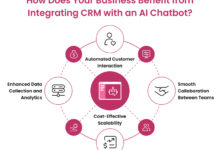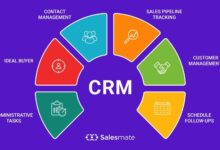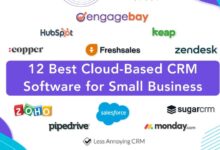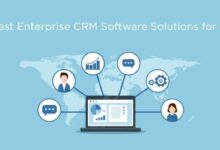CRM Software for Small Business Success
CRM Software for Small Business is more than just software; it’s a strategic investment that can dramatically improve efficiency and customer relationships. This guide explores how the right CRM system can empower small businesses to streamline operations, enhance customer satisfaction, and ultimately, drive significant growth. We’ll delve into choosing the ideal CRM, implementing it effectively, and measuring its impact on your bottom line.
From understanding your specific needs and exploring various software options to mastering implementation and tracking key performance indicators (KPIs), we’ll equip you with the knowledge to make informed decisions and maximize the return on your CRM investment. This comprehensive guide provides a practical, step-by-step approach to leveraging the power of CRM for small business success.
Defining Needs for Small Business CRM
Small businesses often operate with limited resources and personnel, making efficient customer relationship management crucial for growth and sustainability. Implementing a CRM system can significantly improve operational efficiency and enhance customer satisfaction, leading to increased profitability and a stronger brand reputation. This section will explore the key challenges small businesses face in managing customer relationships, the benefits of adopting CRM software, and the essential features a suitable system should offer.
Small businesses frequently grapple with a range of challenges related to managing customer interactions. These difficulties often stem from a lack of centralized information, inefficient communication processes, and limited resources for tracking and analyzing customer data. Overcoming these hurdles is vital for sustained success.
Key Challenges in Customer Relationship Management for Small Businesses
Three significant challenges frequently encountered by small businesses in managing customer relationships are inefficient data management, inconsistent communication, and difficulty in tracking customer interactions and preferences. These issues can lead to lost sales opportunities, decreased customer satisfaction, and a diminished competitive edge.
- Inefficient Data Management: Customer information is often scattered across various platforms – emails, spreadsheets, notes – making it difficult to access a complete customer profile. This fragmented data hinders effective communication and personalized service.
- Inconsistent Communication: Lack of a centralized communication system can result in inconsistent messaging and missed opportunities to engage with customers. Different team members might use different methods, leading to confusion and a lack of follow-up.
- Difficulty Tracking Customer Interactions and Preferences: Without a system to track customer interactions, businesses struggle to understand customer preferences and buying patterns. This limits their ability to personalize marketing efforts and provide targeted support.
Benefits of Implementing CRM Software for Small Businesses
Implementing CRM software offers numerous benefits to small businesses, primarily improving efficiency and boosting customer satisfaction. These improvements translate to increased revenue and a stronger competitive position in the marketplace. A well-chosen CRM system streamlines operations and strengthens customer relationships.
- Improved Efficiency: CRM software automates repetitive tasks like data entry and email marketing, freeing up valuable time for employees to focus on higher-value activities such as building customer relationships and closing deals. For example, automated email sequences can nurture leads and provide timely follow-up, improving sales conversion rates.
- Enhanced Customer Satisfaction: By centralizing customer information and providing a 360-degree view of each customer, CRM software enables businesses to personalize interactions and provide more effective support. This leads to increased customer loyalty and positive word-of-mouth referrals. A bakery, for instance, could use a CRM to track customer preferences for specific pastries and send personalized birthday offers, strengthening customer relationships.
Essential Features of a Small Business CRM
When selecting CRM software, small businesses should prioritize ease of use and affordability while ensuring the system provides the necessary functionalities. The ideal system should be intuitive, cost-effective, and scalable to accommodate future growth. A balance between functionality and simplicity is key.
- Contact Management: A robust contact management system allows for storing and organizing all customer information in a centralized location, providing easy access to relevant details. This feature is fundamental to any CRM system.
- Sales Pipeline Management: Tracking leads and opportunities through the sales process helps businesses identify bottlenecks and improve sales conversion rates. Visual representations of the sales pipeline provide a clear overview of progress.
- Reporting and Analytics: Basic reporting and analytics capabilities allow businesses to track key metrics such as sales performance, customer engagement, and marketing ROI. These insights help inform strategic decision-making.
- Communication Tools: Integrated communication tools, such as email marketing and social media integration, streamline communication with customers and improve response times. This ensures consistent messaging across all channels.
- Ease of Use and Affordability: The CRM system should be intuitive and easy to learn and use, requiring minimal training. Affordability is crucial, especially for small businesses with limited budgets. Cloud-based solutions often offer flexible pricing plans that can adapt to a business’s needs and growth.
Exploring CRM Software Options
Choosing the right CRM software is crucial for small businesses aiming to streamline operations and enhance customer relationships. The market offers a variety of options, each with its own strengths and weaknesses. Understanding these differences is key to making an informed decision. This section will explore different CRM types, provide examples of popular solutions, and outline key factors to consider during the selection process.
Types of CRM Software
Small businesses have several CRM software deployment models to choose from, each with its own set of advantages and disadvantages. Understanding these differences is critical for selecting a system that aligns with the business’s specific needs and resources.
| Type | Cost | Features | Pros & Cons |
|---|---|---|---|
| Cloud-Based CRM | Subscription-based, varying by features and users. Typically lower upfront costs. | Accessibility from anywhere with internet access, automatic updates, scalability, data backup and recovery, often includes collaboration tools. | Pros: Accessibility, affordability, ease of maintenance. Cons: Reliance on internet connectivity, potential security concerns (dependent on provider security measures), vendor lock-in. |
| On-Premise CRM | Higher upfront costs for software and hardware, ongoing maintenance expenses. | Greater control over data and security, customization options, no reliance on internet connectivity. | Pros: Enhanced security, greater control, customization possibilities. Cons: High initial investment, ongoing maintenance costs, limited accessibility, requires dedicated IT resources. |
| Open-Source CRM | Generally free to use, but costs may arise for customization, support, and hosting. | Flexibility and customization, community support, potential cost savings. | Pros: Cost-effectiveness, flexibility, community support. Cons: Requires technical expertise for implementation and maintenance, limited support compared to commercial options, potential security vulnerabilities if not properly maintained. |
Examples of CRM Software for Small Businesses
Several CRM solutions cater specifically to the needs of small businesses. Each offers a unique set of features and capabilities, impacting its suitability for different business models and operational requirements.
Examples include:
HubSpot CRM: A popular free CRM with robust features for marketing automation and sales management. Strengths include its ease of use and extensive free features; weaknesses may include limited customization for complex workflows compared to paid versions.
Zoho CRM: A comprehensive and scalable CRM offering a wide range of features at various price points. Strengths include its affordability and versatility; weaknesses can include a steeper learning curve than some competitors.
Salesforce Essentials: A simplified version of the popular Salesforce platform designed for small businesses. Strengths include its powerful features and integration capabilities; weaknesses include its higher price point compared to other options.
Factors to Consider When Choosing a CRM System
Selecting the right CRM system requires careful consideration of several key factors. These factors ensure that the chosen solution effectively meets the present and future needs of the small business.
Key considerations include:
Scalability: The CRM should be able to grow with the business. Consider the potential for future expansion in terms of users, data volume, and features.
Integration Capabilities: Seamless integration with existing software (e.g., accounting, email marketing) is crucial for efficiency. Check for APIs and pre-built integrations with tools your business already uses.
Customer Support: Reliable customer support is essential, especially for smaller businesses with limited IT resources. Look for options with readily available documentation, FAQs, and responsive support channels.
Ease of Use: The CRM should be intuitive and easy for your team to learn and use. A complicated system can lead to low adoption rates and wasted investment.
Budget: Consider both the upfront costs and ongoing subscription fees. Ensure the chosen solution fits within your budget without compromising essential features.
Implementing and Utilizing CRM Software
Successfully implementing a CRM system requires a well-defined plan and dedicated effort. This section outlines a step-by-step guide for integration, emphasizing data migration and user training, followed by best practices for maximizing CRM effectiveness in sales and customer service.
Step-by-Step CRM Implementation Guide for Small Businesses
Implementing a CRM system involves several key phases. A methodical approach ensures a smooth transition and maximizes the benefits of the new system. Ignoring any of these steps can lead to adoption issues and ultimately, failure to realize the CRM’s potential.
- Needs Assessment and Software Selection: This crucial initial step, already covered, involves identifying your business’s specific requirements and choosing the CRM software that best meets those needs. Consider factors like budget, scalability, and integration capabilities.
- Data Migration: Transferring existing customer data to the new CRM is vital. This process requires careful planning and execution to ensure data accuracy and integrity. Employ a phased approach, starting with a small sample of data to test the migration process before moving the entire database. Thoroughly clean and deduplicate your existing data to avoid importing inaccurate or redundant information.
- System Configuration and Customization: Once the data is migrated, configure the CRM system to match your business processes. This might include setting up workflows, automating tasks, and customizing fields to reflect your specific needs. Consider involving key users in this process to ensure the system aligns with their daily operations.
- User Training: Provide comprehensive training to all users who will interact with the CRM system. This should cover basic navigation, data entry, reporting, and any specialized features. Offer both online resources and hands-on training sessions to cater to different learning styles. Ongoing support and refresher courses are beneficial for maintaining proficiency.
- Testing and Go-Live: Before a full launch, conduct thorough testing to identify and resolve any issues. Start with a pilot group of users to test the system’s functionality and gather feedback. Once the system is stable and users are trained, implement the CRM across the organization.
- Ongoing Monitoring and Optimization: Regularly monitor the CRM system’s performance and user adoption. Gather feedback, identify areas for improvement, and make adjustments as needed. Continuously optimize processes to maximize efficiency and effectiveness.
Maximizing CRM Effectiveness in Lead Generation and Sales Conversion
Effective CRM utilization significantly boosts lead generation and sales conversion rates. By centralizing customer information and automating processes, businesses can streamline their sales funnels and improve overall sales performance.
- Lead Scoring and Prioritization: Assign scores to leads based on various factors, such as engagement level and demographics, to prioritize high-potential prospects. This allows sales teams to focus their efforts on the most promising leads.
- Automated Marketing Campaigns: Leverage the CRM to automate email marketing campaigns, personalized messaging, and targeted advertising to nurture leads and drive conversions.
- Sales Pipeline Management: Visualize the sales pipeline and track the progress of each lead through various stages. This provides valuable insights into sales performance and helps identify bottlenecks.
- Sales Forecasting and Reporting: Use CRM data to generate accurate sales forecasts and track key performance indicators (KPIs). This helps in making informed business decisions and optimizing sales strategies.
Improving Customer Service with CRM Software
CRM systems are invaluable tools for enhancing customer service. They provide a centralized repository of customer information, enabling efficient handling of inquiries and issue resolution.
For example, imagine a small bakery using a CRM. When a customer calls with a question about an order, the representative can instantly access the customer’s order history, past interactions, and preferences. This allows for personalized service and faster resolution of any issues. Similarly, if a customer expresses dissatisfaction, the CRM can track the issue, its resolution, and the customer’s subsequent feedback, ensuring consistent and effective service improvement.
Another example could be a tech support company. When a customer reports a software glitch, the agent can access the customer’s account information, previous support tickets, and software version to diagnose the problem quickly and efficiently. This reduces resolution time and improves customer satisfaction. The CRM can also track the resolution time for each issue, allowing the company to identify and address any service bottlenecks.
Measuring Success and ROI
Implementing a CRM system is an investment, and like any investment, its success needs careful monitoring. Understanding how to measure the effectiveness of your CRM and calculate its return on investment (ROI) is crucial for ensuring its continued value to your small business. This section outlines key performance indicators (KPIs) to track, explains ROI calculation, and details methods for ongoing optimization.
Measuring the success of your CRM implementation goes beyond simply tracking user adoption. It’s about understanding how the system is impacting key business metrics and ultimately contributing to your bottom line. By consistently monitoring relevant KPIs, you can identify areas for improvement and demonstrate the tangible benefits of your investment.
Key Performance Indicators for CRM Success
Tracking the right KPIs provides a clear picture of your CRM’s effectiveness. These metrics should align with your overall business goals and be easily measurable within your CRM system. Regularly reviewing these KPIs allows for proactive adjustments and optimization.
- Lead Conversion Rate: The percentage of leads that convert into paying customers. This KPI shows the effectiveness of your sales process and the quality of leads generated.
- Customer Acquisition Cost (CAC): The total cost of acquiring a new customer. Tracking CAC helps determine the efficiency of your marketing and sales efforts and can be compared against customer lifetime value (CLTV).
- Customer Lifetime Value (CLTV): The predicted total revenue a customer will generate throughout their relationship with your business. A high CLTV indicates strong customer loyalty and retention.
- Customer Churn Rate: The percentage of customers who stop doing business with you within a specific period. A low churn rate is indicative of high customer satisfaction and retention strategies.
- Sales Cycle Length: The average time it takes to close a deal. Reducing this length improves efficiency and increases revenue.
- Sales Team Productivity: Metrics such as number of deals closed per representative, average deal size, and number of calls made per day. These metrics highlight individual and team performance.
- Customer Satisfaction (CSAT): Measured through surveys or feedback mechanisms, this reflects how happy your customers are with your products or services and overall experience.
Calculating Return on Investment (ROI) for CRM Software
Calculating the ROI of your CRM helps justify the investment and demonstrate its value to stakeholders. While precise calculation requires careful data collection, a simplified approach can be used to get a good estimate.
ROI = (Return – Investment) / Investment * 100%
For example, let’s say your CRM software costs $10,000 per year. If, through improved sales efficiency and customer retention, your CRM implementation leads to an additional $25,000 in revenue annually, the ROI would be calculated as follows:
ROI = ($25,000 – $10,000) / $10,000 * 100% = 150%
This indicates a strong return on investment. However, remember to factor in all costs associated with the CRM, including implementation, training, and ongoing maintenance.
Ongoing Optimization of CRM Software Usage
Regularly reviewing and optimizing your CRM usage is key to maximizing its benefits. This is an ongoing process that requires consistent monitoring and adaptation.
- Regular Data Analysis: Analyze your CRM data regularly to identify trends, patterns, and areas for improvement. This data-driven approach informs strategic decisions.
- User Training and Feedback: Provide ongoing training to ensure your team is utilizing the CRM effectively. Gather feedback from users to identify pain points and areas for improvement.
- Process Automation: Automate repetitive tasks such as email marketing, lead nurturing, and reporting to free up time for more strategic activities.
- Integration with Other Tools: Integrate your CRM with other business tools, such as marketing automation platforms and accounting software, to streamline workflows and improve data visibility.
- Regular System Updates: Stay current with software updates and patches to ensure optimal performance and security.
Visual Representation of CRM Benefits
Visual aids can powerfully demonstrate the advantages of CRM software for small businesses. By depicting the streamlined workflows and improved customer relationships, these illustrations help solidify the value proposition and encourage adoption. The following sections present two such visual representations, focusing on communication/workflow and customer retention/loyalty.
Streamlined Communication and Workflow
Imagine a vibrant illustration depicting a small business office. The scene is divided into two distinct halves. The left half shows chaos: employees frantically juggling multiple phones, overflowing inboxes are visible on computer screens, and paper documents are scattered across desks. People look stressed and confused, with arrows indicating disorganized communication pathways crossing each other. The overall color palette is muted and dark, conveying a sense of overwhelm.
The right half of the illustration depicts the same office, but transformed. Employees are calmly working on their computers, smiling and collaborating. A central, clean dashboard displays organized customer information, appointments, and tasks. Communication flows smoothly, represented by brightly colored, neatly organized arrows connecting employees and customers. The color palette is bright and airy, conveying efficiency and ease. The central dashboard visually represents the CRM software, showing its ability to consolidate information and streamline workflows. A key element could be a visual representation of automated tasks, such as email reminders or follow-ups, highlighted with a soft glow. The contrast between the two halves vividly showcases the positive impact of CRM software on communication and workflow.
Impact on Customer Retention and Loyalty
This illustration focuses on the customer journey. It begins with a funnel representing the customer acquisition process. On the left, customers enter the funnel in a large, scattered group. Many drop out at different stages, symbolized by smaller groups exiting the funnel at various points, indicating lost customers due to poor communication or lack of follow-up. This section uses muted colors and less defined customer avatars, suggesting anonymity and a lack of personalized connection.
The right side shows the same funnel, but with a significantly higher retention rate. A larger percentage of customers progress through the funnel to become loyal customers. This is visually represented by a larger group of customers at the bottom of the funnel, represented by brighter, more distinct customer avatars, suggesting a personalized and strong relationship. Arrows connect these loyal customers to positive feedback mechanisms like reviews and testimonials, represented by speech bubbles with glowing positive messages. The color palette is bright and positive, emphasizing the increased customer loyalty and retention. A key element could be a visual representation of personalized interactions, such as targeted marketing campaigns or customized offers, showing how CRM data drives better customer engagement and fosters loyalty. The difference between the two funnels clearly demonstrates the effectiveness of CRM in building lasting customer relationships.
Outcome Summary
Ultimately, implementing the right CRM software is a pivotal step for any small business aiming for sustainable growth. By carefully considering your needs, exploring available options, and diligently tracking your progress, you can transform customer relationships, boost efficiency, and achieve a significant return on investment. Remember, the key to success lies in selecting a system that aligns perfectly with your business goals and consistently optimizing its use for ongoing improvement.





